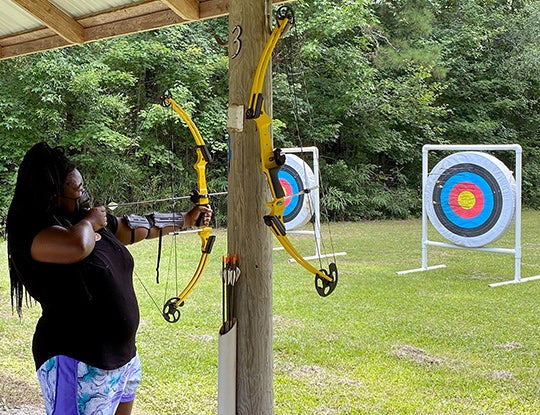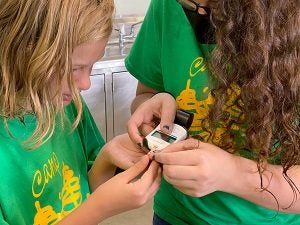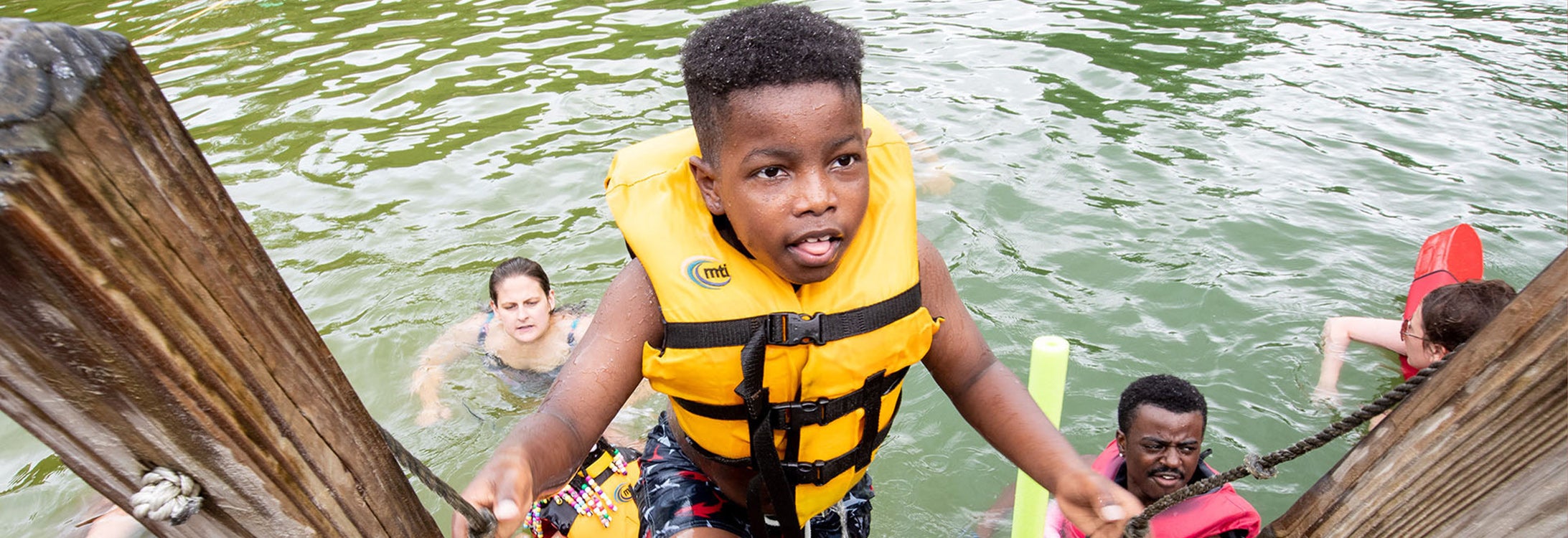PEDIATRIC CAMPS REOPEN
ECU’s camps for children living with health challenges reopen

A camper takes aim during an archery lesson at a session of Camp Needles in the Pines, a camp for children and teens living with diabetes that is hosted by the ECU Brody School of Medicine’s Department of Pediatrics. (Contributed photo by Mindy Saenz)
In a picturesque setting with the signature outdoor features of eastern North Carolina — water, pines, a stretch of blue sky — children living with health care challenges are spending time together and experiencing summer camp.
After a hiatus last summer because of the COVID-19 pandemic, the camps designed for children with specific health conditions once again served their eager clientele through experiences that mirror routine summer camp. While the campers get to make friends and enjoy outdoor adventures and activities, they do so under the care of expert health care providers.
The camps are housed in the Department of Pediatrics in the Brody School of Medicine at East Carolina University, with support from the ECU Medical & Health Sciences Foundation.
Camp Needles in the Pines welcomed back children ages 8 to 14 with Type 1 diabetes to Camp Boddie in Blounts Creek on July 24-25. Although abbreviated from its typical schedule, the camp still provided the campers the opportunity to enjoy activities such as swimming, sailing, canoeing, kayaking, archery, crafts, rifle range, tenting and improved self-help skills. Medical supplies such as insulin testing meters are provided through the camp for the weekend, and the medical staff consists of volunteers from the hospital, medical school and university.
“I love seeing them just play and do all the normal camp things,” said Mindy Saenz, camp director, clinical dietician and certified diabetes care and education specialist for ECU Pediatric Specialty Care. “We are so glad to be able to have camp this year, even though it is a condensed version.”
Saenz said many of the camp’s counselors and medical staff also have diabetes, so they have a deeper understanding of the challenges the children face.
“The kids really love that they are dealing with the same things,” she said.
This year, special safety protocols were put in place, such as mask-wearing any time other than eating, sleeping and swimming, and only one camper occupying each tent instead of the usual two.
During the weekend, dieticians planned the menu and calculated carbohydrate counts for each meal, while each group of campers had a member of the medical staff overseeing insulin dosing for meals.
Saenz said that although a grant allowed the camp to be offered at no charge to campers’ families this year, the support of grants and donations keeps the camp possible for children who love to attend each year.
“Our camp costs approximately $750 per camper, but due to the population we serve, that is not a cost our campers could pay,” Saenz said. “Because we get grants and donations, we have never charged more than $250 for our full week camp. It is the grants and donations that allow us to continue to offer this camp every year. These financial gifts are one way that donors can help us make life better for deserving children in eastern North Carolina.”

A camper participating in Camp Needles in the Pines gets assistance checking blood sugar levels during a pause from camp activities. The camp provides a fun camp experience for children and teens living with diabetes. (Contributed photo by Mindy Saenz)
Camp Rainbow, for ECU pediatric cancer, hemophilia and bleeding disorders patients, and Camp Hope, for the division’s sickle cell disease patients, were held in June. Jacque Sauls, director of Rainbow Services/Child Life for ECU Pediatric Hematology/Oncology, said those weeklong camps were limited to middle- and high-school-age campers, and campers stayed with their cohorts to minimize the chance of COVID-19 exposures. Along with additional safety protocols, those changes were enthusiastically incorporated, since it meant being able to host the camps after a historic closing last summer.
Sauls worked with ECU offices to develop safety protocols that followed state and national recommendations and policies, which included reducing camp capacity to 50%, requiring social distancing and staying with campers’ assigned cohorts and having a negative COVID-19 test three days before camp kicked off. Campers were also monitored throughout the camp duration.
Sauls began working last year to do all she could to reopen the camps this year.
“After facing the disappointment when we had to tell patients that, for the first time since camps began in 1985, we would be unable to take them to camp in 2020, we fought hard to make Camp Rainbow and Camp Hope possible in 2021,” Sauls said.
For the teen campers who were able to attend, camp provided an outlet after a very isolating year of dealing with COVID-19 restrictions.
“These teens, who may already feel isolated from their peers due to their cancer, hemophilia and sickle cell diagnoses and the chronic related symptoms, treatments and frequent absences during hospitalizations and treatments, were even more isolated during the COVID pandemic due to additional concerns about their health,” Sauls said. “Attending Camp Rainbow and Camp Hope gave the teens a chance to get away from home and participate in some fun and challenging camp activities from learning to sail, tie-dyeing T-shirts, swimming and jumping off the rope swing to making new friends and seeing old friends who have the same or a similar diagnosis.”
Sauls said the camp also held a special session for older teen campers to help them better understand, prepare for and develop strategies to manage their health as they transition from pediatric to adult care.
“Being there with my second family at camp is like a vacation,” said one participant at Camp Rainbow and Camp Hope, “and an ‘out’ for me to be with people who go through all the same struggles as me.”
A young adult cancer patient, former camper and current Camp Rainbow volunteer counselor said the experience provides an uplifting memory while dealing with health challenges.
“My favorite things about the camp are the friendships, community, fun activities, great energy from everyone, the endless love, peace and positive memories,” the volunteer said.

A group of campers pauses before heading to their next activity during Camp Rainbow and Camp Hope, which took place in June for young patients living with health challenges. (Contributed photo by Jacque Sauls)
By participating in Camp Rainbow and Camp Hope, the children and teens have an opportunity to make friends with others who have the same or a similar condition and learn that they are not alone in their struggles and triumphs, Sauls said. Campers participate in educational sessions during camp to learn more about their conditions as well as ways to stay healthy and manage their disease and symptoms.
“Attending camp gives these children and teens a much-needed opportunity to learn new skills, meet friends who understand their condition and what they go through and gain independence and confidence while participating in challenging activities that promote self-reliance and prove what they are able to do,” Sauls said. “Campers also meet their doctors, nurses and other health care providers in an environment that is less stressful. Throughout the week, they see the medical staff enjoying activities with them in addition to providing their medical care. These interactions build trust, help them to better understand their diagnoses, and we have seen over the years that children who children and teens who attend camp are more compliant with their medical routines and more interactive with their medical providers.”
Sauls said financial gifts from donors in support of the camps extend beyond their initial value.
“The impact of one week of fun, friendship and specialized medical care for children and teens who attend Camp Rainbow and Camp Hope is a true investment in the lives of children with cancer, sickle cell disease, hemophilia and other chronic blood disorders,” she said. “In the words of our campers, we come to camp each year to meet old friends, make new friends and have fun with our doctors and nurses.”
To make a gift in support of any of these pediatric camps for children living with life-altering illnesses, email Missy Fallon or Jeff McPherson.
